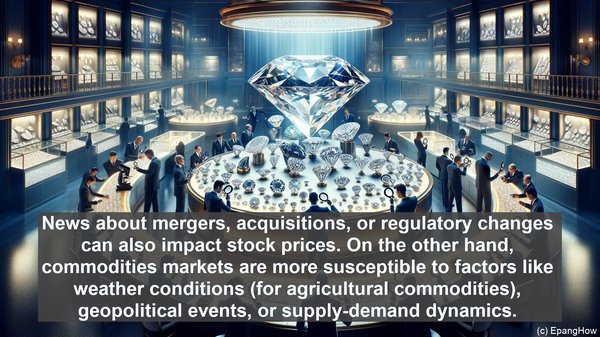Introduction: The Dynamic Landscape of Financial Markets
Greetings, financial enthusiasts! In the vast realm of financial markets, numerous entities play crucial roles. Today, we’ll focus on two such entities: stock exchanges and commodities exchanges. While both facilitate trading, they differ significantly in terms of assets, trading mechanisms, and overall functions. So, let’s dive in and explore these distinctions in detail.
Stock Exchanges: The Epicenter of Equity Trading
When we think of stock exchanges, we envision bustling trading floors, where shares of publicly listed companies change hands. Stock exchanges, such as the New York Stock Exchange (NYSE) or the London Stock Exchange (LSE), primarily deal with equities. These equities, or stocks, represent ownership in companies. Investors can buy or sell these stocks, either through brokers or electronically, using the exchange’s trading platform. Stock exchanges provide a transparent marketplace, ensuring fair pricing and liquidity for investors.
Commodities Exchanges: The Realm of Tangible Assets
In contrast to stock exchanges, commodities exchanges focus on tangible assets. These assets, known as commodities, can be broadly categorized into agricultural products (wheat, corn), energy resources (oil, natural gas), or metals (gold, silver). Commodities exchanges, like the Chicago Mercantile Exchange (CME) or the London Metal Exchange (LME), facilitate the trading of these commodities. Unlike stocks, which represent ownership, commodities are physical goods. Thus, commodities exchanges deal with the buying and selling of contracts, representing future delivery or settlement of these goods.
Trading Mechanisms: Spot vs. Futures
Another key distinction lies in the trading mechanisms. Stock exchanges primarily operate on a spot trading basis. Here, transactions occur in real-time, with immediate settlement. In contrast, commodities exchanges predominantly facilitate futures trading. In futures trading, buyers and sellers agree to a contract, specifying the price and delivery date for the commodity. While the actual delivery may occur later, the contract’s value fluctuates based on market conditions. This futures trading allows for hedging against price volatility, making commodities exchanges vital for industries reliant on these commodities.

Market Influences: Diverse Factors at Play
The forces driving stock and commodities markets differ significantly. Stock markets are influenced by a multitude of factors, including a company’s financial performance, industry trends, or broader economic indicators. News about mergers, acquisitions, or regulatory changes can also impact stock prices. On the other hand, commodities markets are more susceptible to factors like weather conditions (for agricultural commodities), geopolitical events, or supply-demand dynamics. For instance, a drought affecting crop yields can significantly impact grain prices.
Investor Profiles: Diverse Strategies and Risk Appetites
Investors in stock and commodities markets often have distinct profiles. Stock market investors, ranging from individual retail investors to institutional players like pension funds, often focus on long-term wealth creation. They analyze a company’s fundamentals, growth prospects, and other qualitative factors before investing. In contrast, commodities markets attract a diverse set of participants. Apart from speculators aiming to profit from price movements, industries reliant on these commodities, like airlines or manufacturers, use these markets to hedge against potential price fluctuations.

